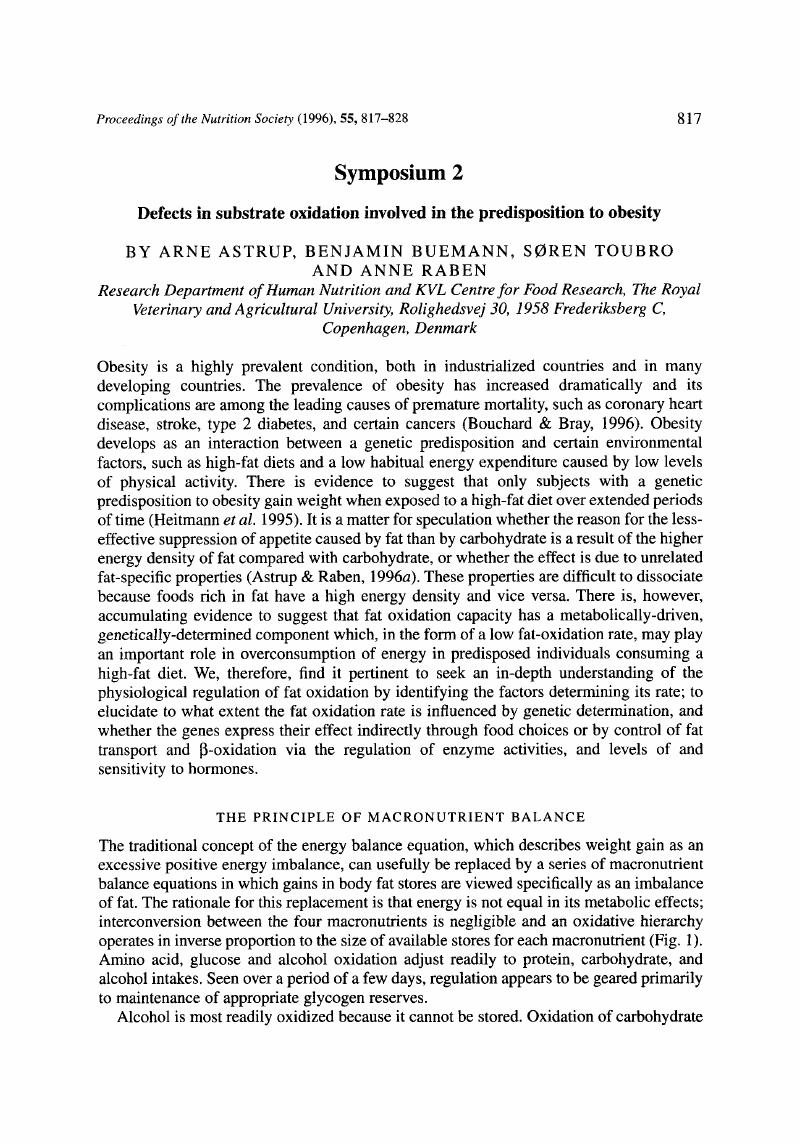Crossref Citations
This article has been cited by the following publications. This list is generated based on data provided by Crossref.
Davidson, Isobel H.
Richardson, Rosemary
Sutherland, Donald
and
Garden, James O.
1999.
Macronutrient Preference, Dietary Intake, and Substrate Oxidation Among Stable Cirrhotic Patients.
Hepatology,
Vol. 29,
Issue. 5,
p.
1380.
James Stubbs, R
and
O’Reilly, Leona
1999.
Neural and Metabolic Control of Macronutrient Intake.
van Gemert, WG
Westerterp, KR
van Acker, BAC
Wagenmakers, AJM
Halliday, D
Greve, JM
and
Soeters, PB
2000.
Energy, substrate and protein metabolism in morbid obesity before, during and after massive weight loss.
International Journal of Obesity,
Vol. 24,
Issue. 6,
p.
711.
Atkin, Lisa-Marie
and
Davies, Peter SW
2000.
Diet composition and body composition in preschool children.
The American Journal of Clinical Nutrition,
Vol. 72,
Issue. 1,
p.
15.
Martinez, J. Alfredo
2000.
Body-weight regulation: causes of obesity.
Proceedings of the Nutrition Society,
Vol. 59,
Issue. 3,
p.
337.
Kirk, T. R.
2000.
Role of dietary carbohydrate and frequent eating in body-weight control.
Proceedings of the Nutrition Society,
Vol. 59,
Issue. 3,
p.
349.
Prentice, Andrew M
2001.
Obesity and its potential mechanistic basis.
British Medical Bulletin,
Vol. 60,
Issue. 1,
p.
51.
Dobbins, Robert L.
Szczepaniak, Lidia S.
Bentley, Brandon
Esser, Victoria
Myhill, Jeffrey
and
McGarry, J. Denis
2001.
Prolonged Inhibition of Muscle Carnitine Palmitoyltransferase-1 Promotes Intramyocellular Lipid Accumulation and Insulin Resistance in Rats.
Diabetes,
Vol. 50,
Issue. 1,
p.
123.
Blaak, Ellen E
and
Saris, Wim H.M
2002.
Substrate oxidation, obesity and exercise training.
Best Practice & Research Clinical Endocrinology & Metabolism,
Vol. 16,
Issue. 4,
p.
667.
Blundell, J. E.
Cooling, J.
and
King, N. A.
2002.
Differences in postprandial responses to fat and carbohydrate loads in habitual high and low fat consumers (phenotypes).
British Journal of Nutrition,
Vol. 88,
Issue. 2,
p.
125.
Blaak, E. E.
2003.
Fatty acid metabolism in obesity and type 2 diabetes mellitus.
Proceedings of the Nutrition Society,
Vol. 62,
Issue. 3,
p.
753.
Marti, A
Moreno-Aliaga, M J
Hebebrand, J
and
Martínez, J A
2004.
Genes, lifestyles and obesity.
International Journal of Obesity,
Vol. 28,
Issue. S3,
p.
S29.
Blaak, Ellen E.
2005.
Metabolic fluxes in skeletal muscle in relation to obesity and insulin resistance.
Best Practice & Research Clinical Endocrinology & Metabolism,
Vol. 19,
Issue. 3,
p.
391.
Levin, Barry E.
and
Clegg, Deborah J.
2006.
Overweight and the Metabolic Syndrome.
Vol. 26,
Issue. ,
p.
83.
Iqbal, Sofia I.
Helge, Jørn W.
and
Heitmann, Berit L.
2006.
Do Energy Density and Dietary Fiber Influence Subsequent 5‐Year Weight Changes in Adult Men and Women?.
Obesity,
Vol. 14,
Issue. 1,
p.
106.
Pomplun, Doreen
Voigt, Anja
Schulz, Tim J.
Thierbach, René
Pfeiffer, Andreas F.
and
Ristow, Michael
2007.
Reduced expression of mitochondrial frataxin in mice exacerbates diet-induced obesity.
Proceedings of the National Academy of Sciences,
Vol. 104,
Issue. 15,
p.
6377.
Kuhlow, Doreen
Zarse, Kim
Voigt, Anja
Schulz, Tim J.
Petzke, Klaus J.
Schomburg, Lutz
Pfeiffer, Andreas F. H.
and
Ristow, Michael
2010.
Opposing effects of dietary sugar and saturated fat on cardiovascular risk factors and glucose metabolism in mitochondrially impaired mice.
European Journal of Nutrition,
Vol. 49,
Issue. 7,
p.
417.
Rosenkilde, M
Nordby, P
Nielsen, L B
Stallknecht, B M
and
Helge, J W
2010.
Fat oxidation at rest predicts peak fat oxidation during exercise and metabolic phenotype in overweight men.
International Journal of Obesity,
Vol. 34,
Issue. 5,
p.
871.
Fernando, Carrasco N.
and
José, Galgani F.
2012.
Etiopatogenia de la obesidad.
Revista Médica Clínica Las Condes,
Vol. 23,
Issue. 2,
p.
129.



